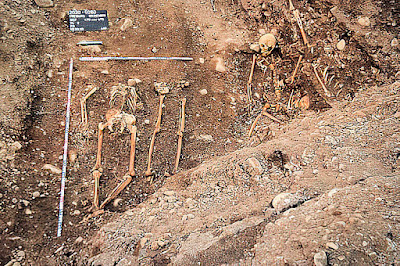Die Siechen im Felde was the title of a talk given by Freiburg's archeologist, Dr. Bertram Jenisch, and anthropologist, Carola Berszin M.A., describing the findings of recent disinterments at the site of the Medieval leprosarium, the Gutleutehaus (good people's house).

|
| ©B. Jenisch |

|
| ©Amt für Denkmalspflege |
It turned out that the unearthed bones originated from the 13th century. The known history of the place is as follows:
1251: First mention of the Freiburg Gutleutehaus (domus pauporum leprosariums de Friburch)
1256: Pope Alexander IV asks the Bishop of Constance* to grant the domus leprosum a chaplain, a campana (bell), and a cimiterium (cemetery).
*Up to the middle of the 19th century, Freiburg belonged to the bishopric of Constance
1268 Albertus Magnus, Lesemeister (lecturer) at Freiburg's Dominican monastery, consecrates the local chapel.
1632 On the occasion of their first siege of Freiburg, Swedish troops burned the site that most likely was not reconstructed. Before the Swedes launched the final attack, the city had the white flag raised on the Snail Tower and bargained for an accord (agreed to surrender) on December 29.

|
|
Blue: The fortifications Vauban had built around the city and up the Schlossberg at the end of the 17th century. Red: The system of trenches (approaches) the besieging French had dug to approach the city walls. The small circle surrounds the area of the former Gutleutehaus. Note: The French had to conquer the fortifications their compatriots had constructed 50 years before. |
At the "Siechen in Felde," archaeologists excavated skeletons marked by leprosy from the Middle Ages. Also, they found a superimposed mass grave of Frenchmen in an upper layer, killed during the siege of Freiburg in 1744. The approaches ran through the former cemetery of the Gutleutehaus and were filled with the corpses of the fallen soldiers.
Anthropologists are just beginning their investigation of Medieval bones, but have already identified diseases such as tuberculosis, bone infections, bone tumors, middle-ear inflammation, and syphilitic
changes.
Based on these preliminary findings, the French disease was not introduced from the New World via Naples, but was already indigenous to Europe; i.e., history books would have to be rewritten.
How exciting, or did they mix the bones from the Middle Ages with those of 1744?
It all remains suspenseful.

|
| Grave good: a rosary (©B. Jenisch) |
Based on these preliminary findings, the French disease was not introduced from the New World via Naples, but was already indigenous to Europe; i.e., history books would have to be rewritten.
How exciting, or did they mix the bones from the Middle Ages with those of 1744?
It all remains suspenseful.
**
This is the kind of mostly-unknown history that I love to read about. I'm glad to begin following your blog, and will read a lot of your older posts too. Thanks, Red Baron!!!
ReplyDelete